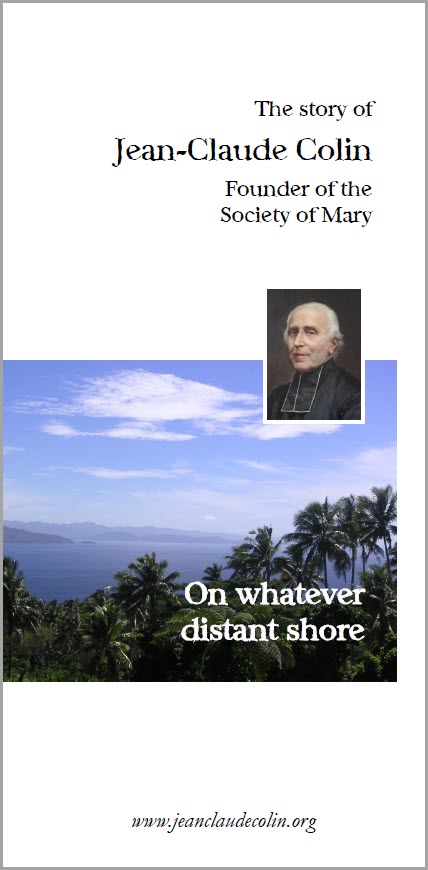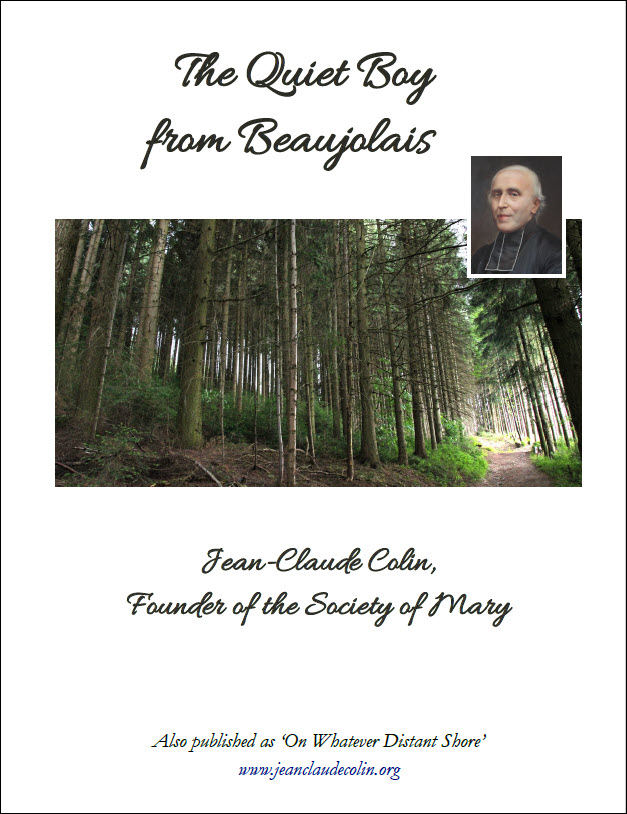Read the story here...
The quiet boy from Beaujolais
The tiny hamlet of Barbery sits by a forest in the Beaujolais region of central France. Here on Aug 07, 1790 Jean-Claude Colin was born, happily unaware of the fierce Revolution raging about him. He was soon to be orphaned, not by violence but through the illness and early death of his mother then his father. Jean-Claude was not yet five years old.
The young Jean-Claude now enjoyed the care of a kindly uncle - and not-so-kindly housekeeper. Before long they moved to the nearby village of St Bonnet-le-Troncy to live close to the church and amidst a community of devout Catholic people many of whom had suffered and lost much through the Revolution. Perhaps the lad would become a priest for them.
Life was simple at St Bonnet for the shy lad... serving Mass in the parish church, minding cows in the fields and never far from the quiet forest of Barbery.
Seminary years
At age fourteen Jean-Claude entered the minor seminary of St Jodard, a secondary school for boys preparing for priesthood, hoping to spend a life of quiet prayer in a gentle ministry. The disciplined lifestyle, obedience and piety came easily to him. The River Loire was nearby, close enough for the lads of St Jodard to stroll by its banks. In 1809 Jean-Claude continued his secondary studies at Alix and finally at Verrières-en-Forez.
Despite being beset with serious illness and questions raised about his suitability for an active life, Jean-Claude handled his studies without difficulty and, indeed, was among the top students.
Vision and promise - the Fourvière pledge
At the end of the summer of 1813 Jean-Claude set off for the major seminary of St Irenaeus at Lyons for the final years of preparation for the priesthood. He was twenty-three years old. Here he met with Jean-Claude Courveille, a fellow seminarian who spoke of an amazing encounter with the Blessed Virgin. Mary had spoken at the cathedral shrine of Le Puy. She wished to have a missionary society bearing her name: Marist.
'Ah, this suits me well', thought Colin, and the stirrings of a missionary spirit began to emerge.
The idea spread amongst a dozen of the young men. They would form Our Lady's Society. It would be a tree with several branches: priests, sisters, brothers and laity.
On Jul 22, 1816, several deacons of St Irenaeus were ordained priest. They included Colin, Courveille and a youthful Marcellin Champagnat.
Next day, Jul 23, twelve Marist aspirants climbed the hill of Fourvière overlooking Lyons to the ancient chapel of the Blessed Virgin. Here, for centuries, Catholics had sought the intercession of Mary for their future dreams. The youthful group solemnly pledged to establish the Society of Mary as soon as they could.
Tasting God - life at Cerdon
Soon after their ordination the newly-ordained Frs Courveille and Champagnat were at once dispatched to parishes in the Lyons archdiocese while the still retiring Jean-Claude Colin was sent to the parish of his older brother, Fr Pierre Colin, in the village of Cerdon, nestling high in the Bugey mountains in the newly-restored diocese of Belley.
As the months went by Jean-Claude Colin began to ponder the Marist project more and more. The winemaking families of Cerdon became his first flock amongst whom he could work in the spirit of Mary.
Who would lead this adventurous project? The outgoing and flamboyant Courveille? Industrious and down-to-earth Champagnat? Or the shy curate of Cerdon?
Colin began to take some important initiatives, firstly in beginning to draw up a rule of life for the Marists-to-be and then to make a visit to Paris and the apostolic nuncio of the time, exploring approval for the project.
The Colin brothers then invited two young women to come to Cerdon to begin the Sister's branch of the Marist project. One was to become its foundress: Jeanne-Marie Chavoin.
Meanwhile Fr Champagnat was establishing the Brothers' branch in his first parish of La Valla. Always he saw Jean-Claude Colin as the leader of the Marist project. And indeed Fr Colin's Cerdon years had seen him grow into a resolute fighter for the Marist cause.
The Society of Mary begins
Sharing the Marist dream with his local bishop Colin met with opposition and ridicule. 'If you want to be missionaries,' said the bishop, 'then start here in the villages of Bugey.'
So Fr Colin did just that. On Oct 29, 1824 the Colin brothers were joined by another of the Fourvière twelve, Etienne Declas. They would form teams to renew the Revolution-torn parishes in the mountains of the diocese. Pierre Colin wrote immediately to the bishop: 'Today the little Society of Mary begins!'.
The Marist group was soon asked to take over the bishop's secondary school at Belley - and the Marist Fathers entered the world of education. Fr Colin soon provided his fellow teachers with firm, gentle guidelines which were to inspire later generations of Marist educators.
The Bugey missions
The mountainous region of Bugey is part of the great massif separating France from Switzerland. Its many rural parishioners had been ill-treated by the French Revolution. Many parish priests had been killed or exiled by the revolutionaries while others remained disheartened and ineffective. It was to these remote communities that the pioneer Marist missionaries were sent to restore faith and hope and to bring the mercy of God to a neglected people.
The Marist missions were possible only during the harsh months of the Bugey winters when farmers and their stock were housebound. Fr Colin and his confreres were often housed in deserted, run-down presbyteries and preached their missions in unheated churches. In such conditions Fr Colin was to say 'never was life so difficult, yet never were we happier.'
Rome - and missions 'on whatever distant shore'
In 1830 Fr Colin was elected 'central superior' of the Marist groups of Lyon and Belley. In early 1833 Fr Colin made the first of five journeys to Rome to plead for approval of the Marist project and its later development. At first the curial authorities said 'No... a multi-branched society with one superior of priests, religious and lay alike. Monstrous!'
In 1836, the opportunity came. The mission-minded Pope Gregory XVI was looking for missionaries for the south-west Pacific -- and the Marists were suggested. When the word got to Jean-Claude Colin he said simply, 'We will do the work of Mary on whatever distant shore'. And the priests' branch of the Society of Mary was approved.
The first professions -- and Pacific missions
The first professions of the priests and brothers of the Society of Mary took place in the chapel of La Capucinière, by now the residence of the Belley Marists. In this ceremony the group formally joined the Society by taking the three vows of poverty, chastity and obedience. Reluctantly Fr Colin agreed to become the first superior-general of the new Marist institute.
Immediately after the first Marist profession Fr Colin set about preparing the pioneer mission band for Oceania. It would be led by Bishop Pompallier, newly-consecrated vicar apostolic of Western Oceania. Amongst the small but enthusiastic band of missionaries was the gentle Fr Peter Chanel, soon to become the first martyr of the Pacific.
After months of waiting for favourable winds the group left the French port of Le Havre on Christmas Eve of 1836. Most would never see their homeland again.
The Society of Mary grows
In 1839 Jean-Claude Colin moved from Belley to Lyons. In subsequent years he led the Society of Mary through years of extraordinary growth both in France and Oceania.
Many bishops were calling for Marist schools in their dioceses. The demand for more missionaries in the Pacific never stopped. Vocations to the infant apostolic group blossomed as Marists were to be found in an increasing number of ministries, especially amongst the young.
In the midst of this growth was the person of Jean-Claude Colin, founder and father of Marists near and far.
And whilst his dream of a family with several branches was never approved by the Holy See, each branch soon received the Church's recognition: the Marist Brothers under Fr Champagnat's leadership and the Marist Sisters with Jeanne-Marie Chavoin.
Marist lay groups were already emerging and later decades would see the appearance of a new branch: the Missionary Sisters of the Society Mary.
La Neylière years
In 1854 Fr Colin succeeded in a long ambition of shedding the leadership of the Society of Mary. Now he could retire to do the work of perfecting the Marist rule and constitutions while others would take over the administration of Mary's little society.
He moved to the rural retreat of La Neylière to do this work, emerging from time to time to take part in chapters and retreats where he never failed to inspire the Marists of the day. The constitutions he had so long labored over were accepted by the general chapter of 1872.
Jean-Claude Colin died at La Neylière on Nov 15, 1875 at the age of 85.
Today his giant strides for the beloved Society of Mary inspire young people of the world -- and the Marists of today -- to continue the work of Mary: simply, generously and in her gentle spirit.
And they will do this 'on whatever distant shore'.
|


